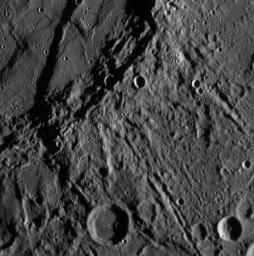
|
Detailed Close-up of Mercury’s Previously Unseen Surface
- Click the image above for a larger view
- Full-Res JPEG (1016 x 1024) (182.8 kB)
- Full-Res TIFF (1016 x 1024) (1.0 MB)
Caption:
Just 21 minutes after MESSENGER's closest approach to Mercury, the Narrow Angle Camera (NAC) took this picture showing a variety of intriguing surface features, including craters as small as about 400 meters (about 400 yards) across. This is one of a set of 68 NAC images showing landscapes near Mercury's equator on the side of the planet never before imaged by spacecraft. From such highly detailed close-ups, planetary geologists can study the processes that have shaped Mercury's surface over the past 4 billion years. One of the highest and longest scarps (cliffs) yet seen on Mercury curves from the top center down across the left side of this image. (The Sun is shining low from the right, so the scarp casts a wide shadow.) Great forces in Mercury's crust have thrust the terrain occupying the right two-thirds of the picture up and over the terrain to the left. An impact crater has subsequently destroyed a small part of the scarp near the bottom of the image.
This image was taken from a distance of only 5,800 kilometers (3,600 miles) from surface of the planet and shows a region about 200 kilometers (about 125 miles) across.
Mission Elapsed Time (MET) of image: 108826105
Background Info:
These images are from MESSENGER, a NASA Discovery mission to conduct the first orbital study of the innermost planet, Mercury. For information regarding the use of images, see the MESSENGER image use policy .
Cataloging Keywords:
| Name | Value | Additional Values |
|---|---|---|
| Target | Mercury | |
| System | ||
| Target Type | Planet | |
| Mission | MESSENGER | |
| Instrument Host | MESSENGER | |
| Host Type | Orbiter | |
| Instrument | Mercury Dual Imaging System (MDIS) | |
| Detector | Narrow Angle Camera (NAC) | |
| Extra Keywords | Crater, Grayscale, Impact, Shadow | |
| Acquisition Date | ||
| Release Date | 2008-01-16 | |
| Date in Caption | ||
| Image Credit | NASA/Johns Hopkins University Applied Physics Laboratory/Carnegie Institution of Washington | |
| Source | photojournal.jpl.nasa.gov/catalog/PIA10174 | |
| Identifier | PIA10174 | |
